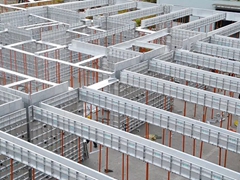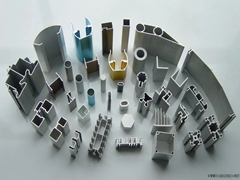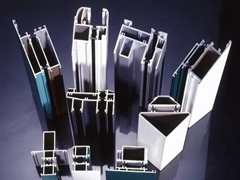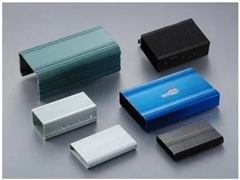What are the stamping requirements for architectural aluminum profiles
Because the material of the stamping parts of architectural aluminum profiles is softer than metal iron, the price is higher, and it is easy to break, so some aluminum alloy products need subsequent processing. Construction aluminum profile manufacturers should pay special attention to the following points in mold manufacturing:
1. Punch holes should be arranged behind the items without affecting the number of items. Even for a product with a large number of punched holes, you can consider doing one more project, and the punching holes should be arranged at the back.
2. Aluminum is softer, so the mold is easier to block. Therefore, when designing the mold gap, a gap of 10% of the thickness of the bilateral material should be reserved.
3. When bending, aluminum scraps are easily generated when the aluminum profile is bent, which will cause point damage and indentation to the architectural aluminum profile. Aluminum raw material needs to be covered with PE film. Hard chrome plating is preferred.
4. For the processed stamping parts, if the flattening and flattening process is Chen Baiqiang, 180 yuan, the product cannot be fully compacted, which will cause acid spitting. Therefore, a certain seam should be left to allow the acid to flow out smoothly and in time. So in this process, a stop must be made, and the calibration mold must be higher than the mold.
5. Because the building aluminum profile is fragile and easy to crack, especially in the case of reverse folding, try not to press the line. Even if you do, make the lines wider and shallower.
6. All aluminum parts are required to be cut by wire to prevent burrs and blank blanking.
Precautions:
Clean, the mold needs to be clean from top to bottom without debris.
In order to stamp the building aluminum profiles well and reduce the defect rate, 5S cleaning is required first, especially the molds, punches, assembly lines, and packaging materials need to be free of sharp debris and dirt, and should be cleaned and rectified regularly. Upper and lower dies need to be clean and free of debris.
If it is found that the product has a large burr, it must be sent to the mold for repair in time, and the results should be followed up.
For products with more holes, it is necessary to punch and clean the surface of the mold, so that the mold and the product are always clean and free of debris and reduce top damage.
In order not to affect the number of engineering punching holes for construction aluminum profiles, construction aluminum profile manufacturers try to punch as many engineering holes as possible, and even punch more products. Consider doing a rear engineering punch. The aluminum alloy material is relatively soft, and the mold is easy to block. Therefore, when designing the mold gap, use double-sided material, the gap is 10%, the blade diameter is 2mm, the taper is 0.8, and the bending is -1.3. Because the aluminum plate is easy to produce aluminum powder during the bending process, it will cause point damage and indentation, so the pe film should be pasted on the raw material of the aluminum plate.
In the processing of architectural aluminum profiles, because the aluminum alloy is relatively brittle and easy to crack, especially in the case of folding back, try not to press the line. To prevent burrs and stamping problems, aluminum alloys are prone to high temperatures, and the stamping hardness should be above 60 yuan. The aluminum plate should be stamped well to reduce the defect rate. There should be no sharp debris in the molding machine, assembly line, and packaging materials. It should be cleaned regularly and there should be no dirt. The top and bottom of the mold need to be clean and free of debris.
If it is found that the product has large burrs, it must be repaired. Aluminum alloy parts are stacked together and are more likely to be hardened by heat, so oil is pressed at the punching point and then pressed. In order to stamp more products, the die surface needs to be cleaned.
1. Punch holes should be arranged behind the items without affecting the number of items. Even for a product with a large number of punched holes, you can consider doing one more project, and the punching holes should be arranged at the back.
2. Aluminum is softer, so the mold is easier to block. Therefore, when designing the mold gap, a gap of 10% of the thickness of the bilateral material should be reserved.
3. When bending, aluminum scraps are easily generated when the aluminum profile is bent, which will cause point damage and indentation to the architectural aluminum profile. Aluminum raw material needs to be covered with PE film. Hard chrome plating is preferred.
4. For the processed stamping parts, if the flattening and flattening process is Chen Baiqiang, 180 yuan, the product cannot be fully compacted, which will cause acid spitting. Therefore, a certain seam should be left to allow the acid to flow out smoothly and in time. So in this process, a stop must be made, and the calibration mold must be higher than the mold.
5. Because the building aluminum profile is fragile and easy to crack, especially in the case of reverse folding, try not to press the line. Even if you do, make the lines wider and shallower.
6. All aluminum parts are required to be cut by wire to prevent burrs and blank blanking.
Precautions:
Clean, the mold needs to be clean from top to bottom without debris.
In order to stamp the building aluminum profiles well and reduce the defect rate, 5S cleaning is required first, especially the molds, punches, assembly lines, and packaging materials need to be free of sharp debris and dirt, and should be cleaned and rectified regularly. Upper and lower dies need to be clean and free of debris.
If it is found that the product has a large burr, it must be sent to the mold for repair in time, and the results should be followed up.
For products with more holes, it is necessary to punch and clean the surface of the mold, so that the mold and the product are always clean and free of debris and reduce top damage.
In order not to affect the number of engineering punching holes for construction aluminum profiles, construction aluminum profile manufacturers try to punch as many engineering holes as possible, and even punch more products. Consider doing a rear engineering punch. The aluminum alloy material is relatively soft, and the mold is easy to block. Therefore, when designing the mold gap, use double-sided material, the gap is 10%, the blade diameter is 2mm, the taper is 0.8, and the bending is -1.3. Because the aluminum plate is easy to produce aluminum powder during the bending process, it will cause point damage and indentation, so the pe film should be pasted on the raw material of the aluminum plate.
In the processing of architectural aluminum profiles, because the aluminum alloy is relatively brittle and easy to crack, especially in the case of folding back, try not to press the line. To prevent burrs and stamping problems, aluminum alloys are prone to high temperatures, and the stamping hardness should be above 60 yuan. The aluminum plate should be stamped well to reduce the defect rate. There should be no sharp debris in the molding machine, assembly line, and packaging materials. It should be cleaned regularly and there should be no dirt. The top and bottom of the mold need to be clean and free of debris.
If it is found that the product has large burrs, it must be repaired. Aluminum alloy parts are stacked together and are more likely to be hardened by heat, so oil is pressed at the punching point and then pressed. In order to stamp more products, the die surface needs to be cleaned.





Leave a comment